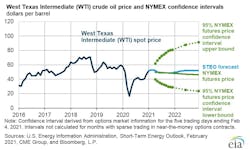EIA forecasts lower oil prices later in 2021 on rising supply
The US Energy Information Administration (EIA) expects Brent crude oil prices will average $56/bbl in first-quarter 2021 and $52/bbl over the remainder of the year. The forecast, part of EIA’s February Short-Term Energy Outlook (STEO), also included the expectation of lower oil prices later in the year as a result of rising oil supply that will slow the pace of global oil inventory withdrawals. Also, high global oil inventory levels and spare production capacity will limit upward price pressures. EIA expects Brent prices will average $55/bbl in 2022, $2/bbl higher than previously forecast.
Brent crude oil spot prices averaged $55/bbl in January, up $5/bbl from the December average but $9/bbl lower than the average in January 2020. Higher Brent prices in January largely reflected the Jan. 5 announcement by Saudi Arabia that it would unilaterally cut 1 million b/d of crude oil production in February and March, in addition to the reduced production levels on which the Organization of the Petroleum Exporting Countries (OPEC) and partner countries (OPEC+) previously agreed.
EIA expects that global consumption of petroleum and liquid fuels will rise by 5.4 million b/d in 2021, which is 200,000 b/d less than forecast in January’s STEO. That pace of growth would bring global petroleum and liquid fuels consumption to an average of 97.7 million b/d for the year, still 3.5 million b/d less than in 2019. EIA forecasts that consumption of petroleum and liquid fuel will increase by 3.5 million b/d in 2022 to average 101.2 million b/d.
US crude production
EIA estimates that US crude oil production averaged 11.0 million b/d in January, which is down slightly from 11.1 million b/d in November (the most recent month for which historical data are available). EIA expects production will continue to decline slightly in the coming months, reaching 10.9 million b/d in June. Although oil-directed drilling has increased in recent months, the number of active drilling rigs remains lower than year-ago levels. EIA expects production from newly drilled wells will be more than offset by declining production rates at existing wells in first-half 2021.
However, based on EIA’s forecast that West Texas Intermediate (WTI) crude oil prices will remain near or higher than $50/bbl during the forecast period, EIA expects drilling will continue to increase. As a result, production from new wells will exceed the declines from legacy wells, and overall crude oil production will increase in second-half 2021 and in 2022. EIA estimates that US crude oil production will average 11.0 million b/d in 2021—down from 11.3 million b/d in 2020 and 12.2 million b/d in 2019—and will rise to 11.5 million b/d in 2022.
Meantime, EIA forecasts Federal US Gulf of Mexico crude oil production will average almost 1.7 million b/d in both 2021 and 2022, which is 100,000 b/d lower than previously forecast. The reduced forecast reflects both announcements by operators that they will push back the start dates of several fields as well as initial production rates that were lower than EIA’s previous expectations at fields that came online in second-half 2020.
US natural gas
EIA expects that total US consumption of natural gas will average 81.7 bcfd in 2021, down 1.9% from 2020. The decline in total US consumption reflects less natural gas consumed for electric power as a result of higher natural gas prices compared with last year.
In January, the Henry Hub natural gas spot price averaged $2.71/MMbtu, up from the December average of $2.59/MMbtu. EIA expects Henry Hub spot prices to reach a monthly average of $2.98/MMbtu in February 2021. Higher expected prices in February reflect expectations of continued strong LNG exports and a shrinking surplus of natural gas in storage compared with the 5-year (2016– 20) average.
Recent forecasts for mid-February weather from the National Oceanic and Atmospheric Administration (NOAA) show cold temperatures could extend across much of the US, which creates an upside risk to near-term prices in this outlook. EIA expects that Henry Hub spot prices will average $2.95/MMbtu in 2021, which is up from the 2020 average of $2.03/MMbtu.
EIA expects that continued growth in LNG exports and in domestic natural gas consumption outside of the electric power sector, as production remains relatively flat, will contribute to Henry Hub spot prices rising to an average of $3.27/MMbtu in 2022.
EIA forecasts that US production of dry natural gas will average 90.5 bcfd in 2021 and 91.0 bcfd in 2022—down from an average of 91.3 bcfd in 2020 and 93.1 bcfd in 2019. Flat natural gas production is the result of falling production in several of the smaller natural gas producing regions being offset by growth in other regions, most notably in the Appalachia and Haynesville regions.
EIA estimates that US exported 9.8 bcfd of LNG in January amid high spot natural gas prices in Asia. However, foggy conditions and high winds affected export operations at Sabine Pass LNG, Corpus Christi LNG, and Cameron LNG, leading to several weather-related closures and sporadic suspension of piloting services on several days in January. EIA forecasts that US LNG exports will average 8.5 bcfd in 2021. In 2022, EIA forecasts LNG exports will average 9.2 bcfd, surpassing the amount of natural gas exported via pipeline for the first time.

